what happens to anne frank concentration camp after she died
Though documented by many witnesses, Anne Frank'south concluding months are rarely probed by teachers, filmmakers or others seeking to brand the diarist's vox relevant.
For starters, the details of Frank's mail service-capture incarceration are not exactly uplifting: The vii month-long demise of a 15-year erstwhile girl through starvation, scabies and typhus is a poor postscript to the "people are really good at middle" bulletin, the 1 most lifted from her diary.
Seventy years ago this calendar month, Frank and her Hush-hush Addendum co-fugitives arrived at Auschwitz-Birkenau in a sealed cattle car. Theirs had been the final deportation train from the Netherlands' Westerbork transit military camp, afterward two years of weekly "transports" brought 100,000 Dutch Jews to the death factories.
For decades, the public knew almost aught about Frank's post-capture feel, except that she died with her sister Margot at a place called Bergen-Belsen.
Finally, in 1988, a Dutch television documentary – aptly named "The Final 7 Months of Anne Frank" – fleshed out what happened to Frank after her deportation from Amsterdam.
For the beginning time, Diary fans heard from six women whose paths crossed Frank at the end of her life. Filmmaker Willy Lindwer interviewed some of the women on-site at the former camps, and he besides compiled the unedited interviews for a book.
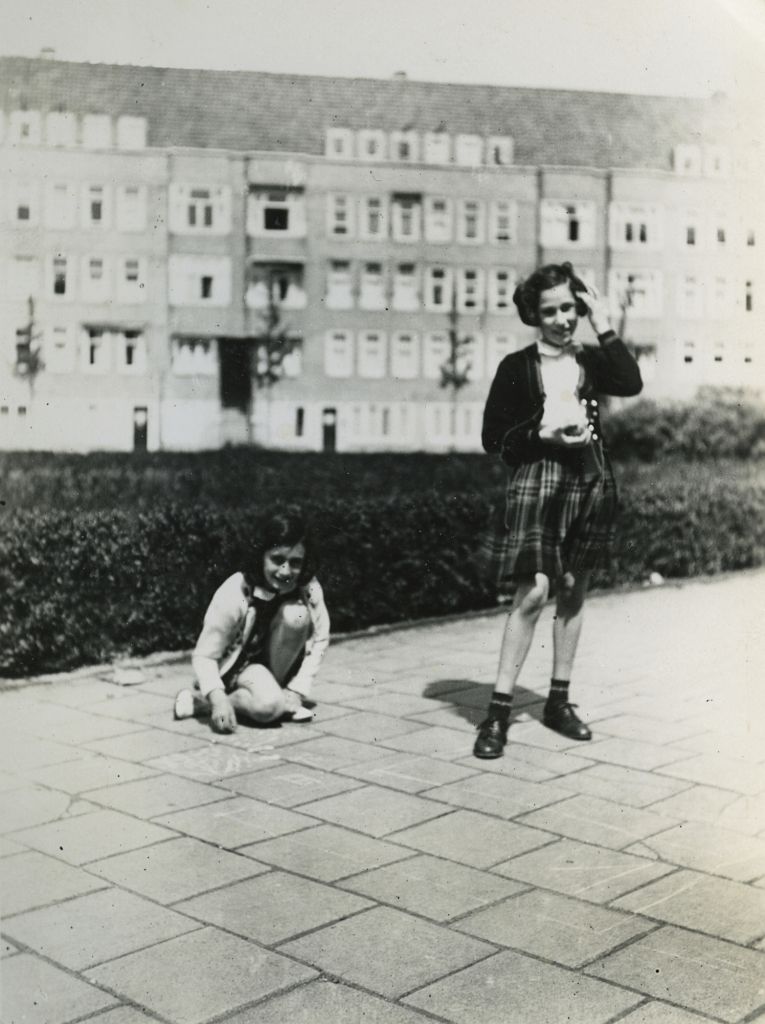
Anne Frank (Fifty) plays with her friend Hanneli Goslar (R) on the Merwedeplein foursquare in Amsterdam, May 1941 (photo credit: AP Photograph/Anne Frank House Amsterdam/Anne Frank Fonds Basel photo collections)
Frank arrived at Auschwitz-Birkenau after an unprecedented, summer-long killing frenzy in which more than 400,000 Hungarian Jews were gassed.
The Frank and van Pels families had maintained good wellness during ii years in hiding, so they survived the initial "selection" between work and expiry. Even having landed in Auschwitz, the families could hope that labor and a swift Allied victory would see them through.
Survivor Ronnie Goldstein-van Cleef met the Frank family at Westerbork, and was close with Anne in the Birkenau labor camp.
'Anne was very calm and quiet and somewhat withdrawn'
"Anne oftentimes stood side by side to me [at curlicue call] and Margot was close by," said Goldstein-van Cleef, who recalled taking turns sipping "coffee" from a cup with Frank and four other women each morning.
"Anne was very calm and quiet and somewhat withdrawn. The fact that they had ended up there had afflicted her profoundly – that was obvious," said the survivor.
After several weeks at Birkenau, the Frank sisters contracted the skin mites which cause scabies, a ravenous camp mainstay. Confined to the scabies barrack, the girls were without their female parent's care for the first time.
"The Frank girls looked terrible, their hands and bodies covered with spots and sores from the scabies," Goldstein-van Cleef told Lindwer. "They were in a very bad way; sad – that'southward how I thought of them," she said.
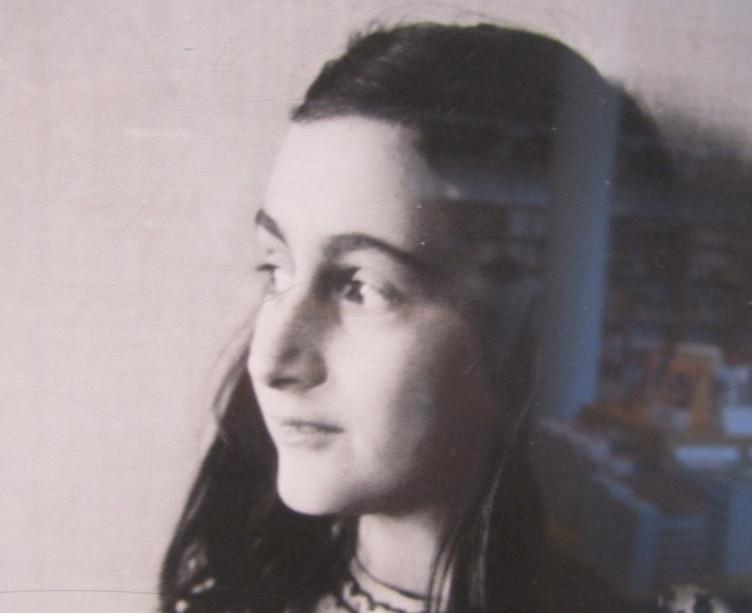
Photo taken in the Anne Frank House book store with her image and translated copies of the diary in the background (photo credit: Matt Lebovic/The Times of State of israel)
Lenie de Jong-van Naarden was some other Dutch Jew who knew the Frank women at Auschwitz. When the sisters were confined to the scabies barrack, she helped Edith Frank dig a pigsty under the structure to smuggle bread to her daughters.
"In the barracks where [the Frank girls] were, women went crazy, completely crazy," said de Jong-van Naarden, who, forth with other witnesses, observed Edith Frank's tireless devotion to her children.
'In the barracks where [the Frank girls] were, women went crazy, completely crazy'
"There were people who threw themselves against the electric fence," said de Jong-van Naarden. "To work it out completely solitary – that didn't piece of work; even very strong women broke down," she said.
Survivor Bloeme Evers-Emden offset met Anne Frank in 1941, when Jewish children were forced to attend the same schoolhouse in Amsterdam – the Jewish Lyceum. Reunited at Auschwitz, the teenagers spoke about the war's price on their families.
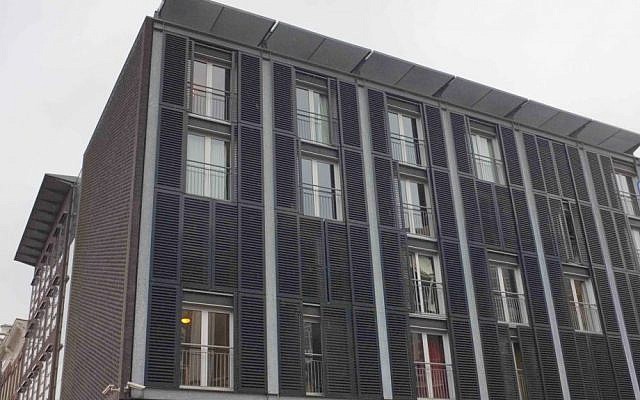
View of the Anne Frank business firm in Amsterdam, Holland, where Anne and her family unit hid in a 'Underground Annex' during the Holocaust. (Nati Shohat/Flash90)
"When [Anne] was in hiding, which was a very unhealthy situation, her mother was someone against whom she rebelled," Evers-Emden said in her interview. "But in the camp, all of that actually completely fell abroad. By giving each other mutual support, they were able to keep each other alive – although no one tin fight typhus," she added.
Every bit the Russian army avant-garde into Poland during October, many of the military camp'southward 39,000 women prisoners – Anne and Margot amid them – were transported westward to Germany. Having been forced to stay behind, Edith Frank died of exhaustion and grief in early 1945.
Anne Frank's last chapter
Bergen-Belsen, on an isolated, desolate heath in northern Germany, would exist the Frank sisters' final dwelling.
Though not equipped with killing facilities, Bergen-Belsen became severely overcrowded and disease-plagued with the arrival of transports from Auschwitz and other camps. Dozens of mass graves were filled during the war'south last winter, including i with the Frank sisters.
Rachel van Amerongen-Frankfoorder is one of several women who told Lindwer well-nigh the Franks' slow decline in a campsite known for "unorganized hell," in contrast to Auschwitz-Birkenau's "organized hell."
"They had little squabbles, caused past their illness, considering it was clear they had typhus," said van Amerongen-Frankfoorder, who commencement met the Frank family at Westerbork.
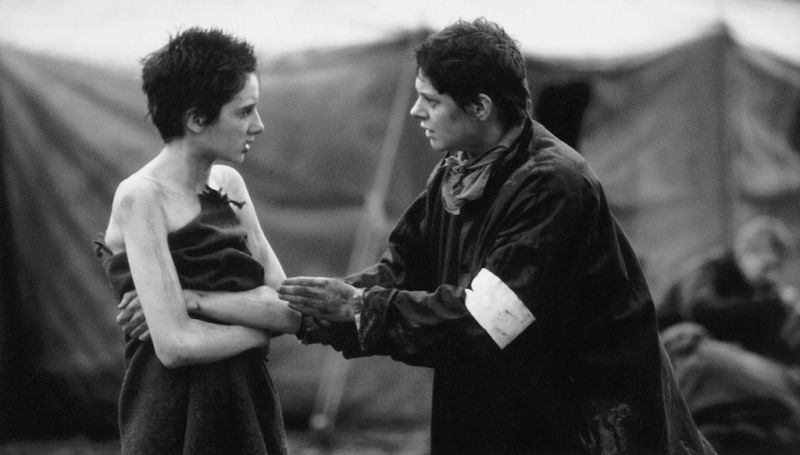
Every bit depicted in the 2001 Disney-made boob tube movie, Anne Frank (left) is comforted by Janny Brandes-Brilleslijper at Bergen-Belsen during the diarist'southward final days. Brandes-Brilleslijper was 1 of 6 women interviewed for the documentary and book, 'The Last Seven Months of Anne Frank.' (photo courtesy: Buena Vista Home Entertainment)
"Typhus was the authentication of Bergen-Belsen," she said. "[Anne and Margot] had those hollowed-out faces, skin over bone. They were terribly cold. They had the least desirable places in the barracks, beneath, near the door, which was constantly opened and airtight. You could actually see both of them dying," said Amerongen-Frankfoorder.
Survivor Janny Brandes-Brilleslijper gave Lindwer the well-nigh detailed account of the Frank sisters' last days. For months, she had helped "organize" food and vesture for the girls, whose bodies ultimately succumbed to typhus.
"At a certain moment in her final days, Anne stood in front end of me, wrapped in a coating," Brandes-Brilleslijper said.
'She told me that she had such a horror of the lice and fleas in her dress and that she had thrown all of her clothes away'
"She didn't accept any more than tears, and she told me that she had such a horror of the lice and fleas in her wearing apparel and that she had thrown all of her clothes away. It was the heart of winter and she was wrapped in i blanket. I gathered up everything I could find to give her so that she was dressed again," said the survivor.
3 days later her disturbing encounter with Frank, Brandes-Brilleslijper learned that both sisters were dead.
"First, Margot had fallen out of bed onto the stone flooring," said Brandes-Brilleslijper. "She couldn't get upwards anymore. Anne died a day afterwards. Iii days before her death from typhus was when she had thrown away all of her clothes during dreadful hallucinations. That happened but before the liberation," the survivor said in the documentary.
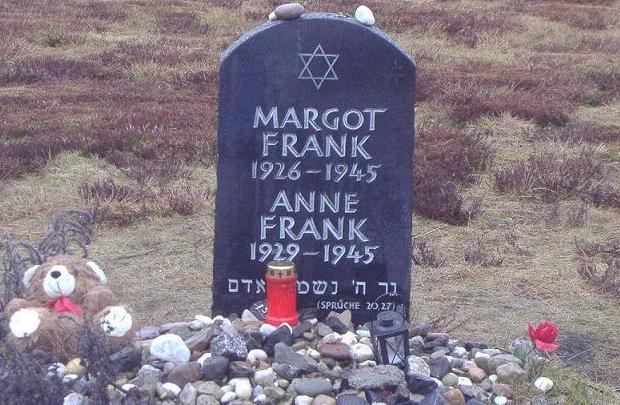
Symbolic grave for Anne and Margot Frank at Bergen-Belsen, where the sisters perished in March of 1945 (photo credit: public domain)
Earlier that wintertime, with just weeks to alive, the Frank sisters helped Brandes-Brilleslijper and other women accept intendance of a large group of Dutch "mixed race" children placed in the camp. With Centrolineal victory a near certainty, authorities constitute it more expedient to maintain the children than destroy them.
"Nosotros did our best to help them," said Brandes-Brilleslijper. "Non only Anne and Margot, merely also the other girls nosotros knew went regularly to provide them with a little balance and sometimes a piddling culture," she said.
Survivors of all 3 camps in which Frank spent fourth dimension spoke nigh her instruction and entertaining children, also as making deep human connections. Even in Bergen-Belsen, convinced that both her parents were dead, the Diary's "immature daughter" uplifted others.
Source: https://www.timesofisrael.com/what-happened-to-anne-frank-after-the-secret-annex/
Post a Comment for "what happens to anne frank concentration camp after she died"